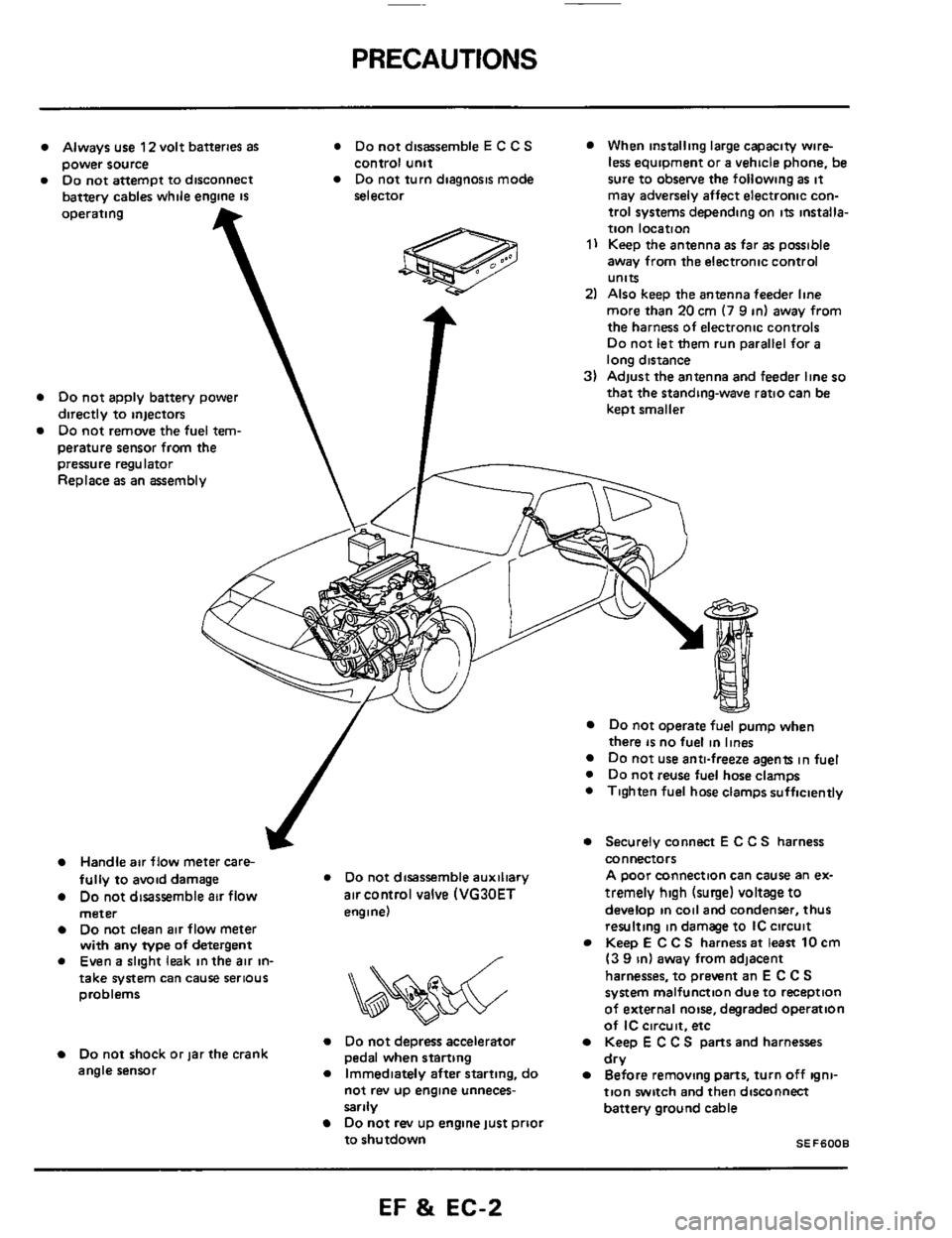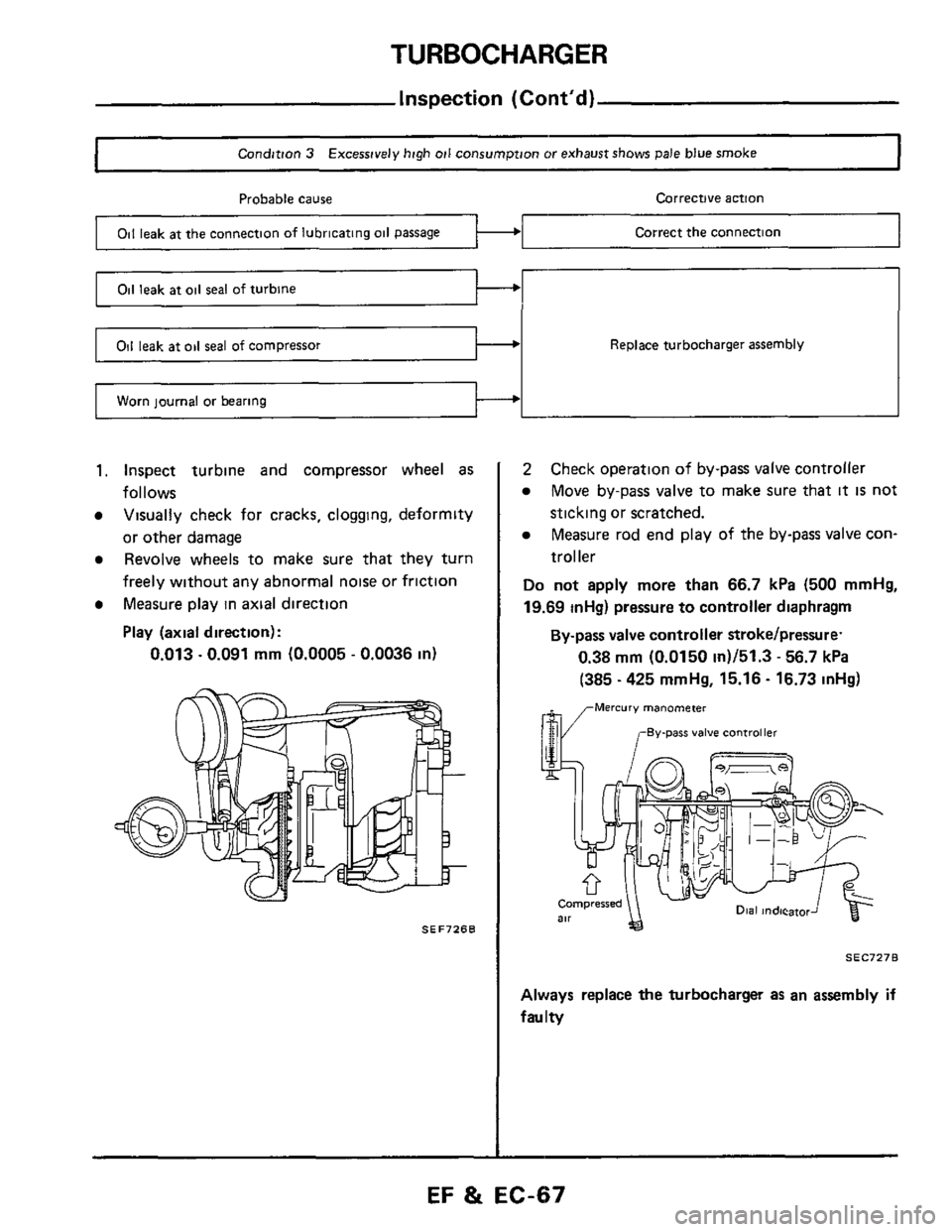Page 2 of 79

PRECAUTIONS
Always use 12 volt batteries as * Do not disassemble E C C S When installing large capacity wire-
Do not attempt to disconnect Do not turn diagnosis mode sure to obsetve the following as it power source
battery cables while engine
IS
control unit
selector less equipment or a vehicle phone, be
may adversely affect electronic con-
operating
Do not apply battery power
directly to injectors
Do not remove the fuel tem-
perature sensor from
the T
pressure regulator
Replace as an assembly
trol systems depending on its installa-
tion location
1) Keep the antenna as far as possible
away from the electronic control
units
2) Also keep the antenna feeder line
more than
20 cm (7 9 in) away from
the harness of electronic controls
Do not let them run parallel for a
long distance
3) Adjust the antenna and feeder line so
that the standing-wave ratio can be
keot smaller
J
Handle air flow meter care-
fully to avoid damage * Do not disassemble auxiliary
Do not disassemble air flow air control valve (VG30ET
meter engine)
Do not clean air flow meter
with any type of detergent
0 Even a slight leak in the air in- /
&&%$$?&
take system can cause serious
problems
Do not depress accelerator Do not shock or jar the crank
angle sensor
Immediately after starting, do
pedal when starting
not rev
up engine unneces-
sarily
Do not rev up engine just prioi
to shutdown
Do not operate fuel pump when
there is no fuel in lines Do not use anti-freeze agents in fuel
0 Do not reuse fuel hose clamps
0 Tighten fuel hose clamps sufficiently
Securely connect E C C S harness
connectors
A poor connection can cause an ex-
tremely
high (surge) voltage to
develop in coil and condenser, thus
resulting in damage to IC circuit
Keep
E C C S harness at least 10 cm
(3 9 in) away from adjacent
harnesses, to prevent an
E C C S
system malfunction due to reception
of external noise, degraded operation
of
IC circuit. etc
Keep E C C S parts and harnesses
Before removing parts, turn off igni-
tion switch and then disconnect
battery ground cable dry
SEF6008
EF & EC-2
Page 24 of 79
E.C.C.S. DESCRIPTION
Battery voltage Battery
~-
Headlarnp switch Load signal
Cooling fan switch
Power steering oil pressure switch
Idle-up Control (VG30E engine)
Start signal Ignition switch
ECCS
control
unit
The idle speed is compensated by the E C C S
control unit to prevent rough idle when any of the
following conditions
are met
The control unit senses the idle condition, and
determines
ON/OFF signal The signal from con-
trol unit
is transmitted to the idle-uD solenoid valve
to stabilize idle speed.
Condition
During engine start
20 seconds after engine start
Battery voltage is below 12V
Headlarnp switch ON
Cooling fan switch ON
Power steering oil pressure switch ON
Except above
Idle-up solenoid
operation
ON
OFF
EF 8t EC-24
Page 67 of 79

TURBOCHARGER
Worn journal or bearing
Inspection (Cont’d)
Replace turbocharger assembly
I Condition 3 Excessively high oil consumption or exhaust shows pale blue smoke I
Probable cause Corrective action
Oil leak at the connection of lubricating oil passage Correct the connection
1. Inspect turbine and compressor wheel as
follows
Visually check for cracks, clogging, deformity
or other damage
Revolve wheels to make sure that they turn
freely without any abnormal noise or friction
Measure play in axial direction
Play (axial direction):
0.013.0.091 mm (0.0005 - 0.0036 in)
SEF726B
2 Check operation of by-pass valve controller
Move by-pass valve to make sure that
it is not
sticking or scratched.
Measure rod end play of the bypass valve con-
troller
Do not apply more than 66.7 kPa (500 mmHg,
19.69 mHg) pressure to controller diaphragm
0.38 mm (0.0150 in)/51.3 - 56.7 kPa
(385 - 425 mmHg, 15.16 - 16.73 inHg)
By-pass valve controller strokelpressure.
,vMercury manometer
,-By-parr valve controller
SEC7278
Always replace the turbocharger as an assembly if
faultv
EF & EC-67